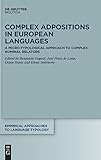Complex Adpositions in European Languages : A Micro-Typological Approach to Complex Nominal Relators / ed. by Benjamin Fagard, José Pinto de Lima, Dejan Stosic, Elena Smirnova.
Material type: TextSeries: Empirical Approaches to Language Typology [EALT] ; 65Publisher: Berlin ; Boston : De Gruyter Mouton, [2020]Copyright date: ©2020Description: 1 online resource (X, 400 p.)Content type:
TextSeries: Empirical Approaches to Language Typology [EALT] ; 65Publisher: Berlin ; Boston : De Gruyter Mouton, [2020]Copyright date: ©2020Description: 1 online resource (X, 400 p.)Content type: - 9783110676938
- 9783110686791
- 9783110686647
- 415 23/eng/20231120
- P285
- online - DeGruyter
- Issued also in print.
| Item type | Current library | Call number | URL | Status | Notes | Barcode | |
|---|---|---|---|---|---|---|---|
 eBook
eBook
|
Biblioteca "Angelicum" Pont. Univ. S.Tommaso d'Aquino Nuvola online | online - DeGruyter (Browse shelf(Opens below)) | Online access | Not for loan (Accesso limitato) | Accesso per gli utenti autorizzati / Access for authorized users | (dgr)9783110686647 |
Frontmatter -- Contents -- Introduction: Complex adpositions and complex nominal relators -- Indo-European language families & isolates -- 1 Complex adpositions in Romance: Emergence and variation -- 2 Complex adpositions in three West Germanic Languages: German, Dutch, and English -- 3 Complex adpositions in Slavic languages: The case of Serbian -- 4 Complex prepositions in Breton -- 5 On complex adpositions in Modern Greek -- 6 Complex prepositions in Albanian: A first assessment -- Non Indo-European languages -- 7 What makes a complex postposition: The cyclic development of postpositions in Estonian -- 8 Complex and simple postpositions: The split in Permic -- 9 Case marking and complex adpositions in Basque -- 10 Structure and origin of Turkish adpositions -- 11 A chapter on compound prepositions in Maltese: prep-prep combinations and related issues -- Discussion -- 12 Complex adpositions in Europe and beyond: A synthesis -- Index -- Language Index
restricted access online access with authorization star
http://purl.org/coar/access_right/c_16ec
While much attention has been devoted to simple nominal relators, especially prepositions and case markers, complex nominal relators have not yet been the focus of a systematic and cross-linguistic study.The chapters of this volume provide not only a working definition of such constructions, but also a description of complex adpositions and other complex nominal relators in a variety of European languages, both Indo-European and non-Indo-European, including some languages for which this phenomenon had received little attention, such as Breton and Albanian. Building on synchronic and diachronic corpus-based investigations, the authors show commonalities and specificities of these linguistic items across languages, trying to explain why and how they emerged.The research presented in this volume confirms the wide-spread use of complex adpositions in Europe, and the data reviewed in the final discussion suggests it might be the same in other parts of the world, as well. This book thus offers not only detailed descriptions of complex nominal relators in fifteen languages, but also indications of what to look for in other languages, and how to distinguish between a syntactically free sequence and a genuine complex nominal relator.
Issued also in print.
Mode of access: Internet via World Wide Web.
In English.
Description based on online resource; title from PDF title page (publisher's Web site, viewed 25. Jun 2024)


